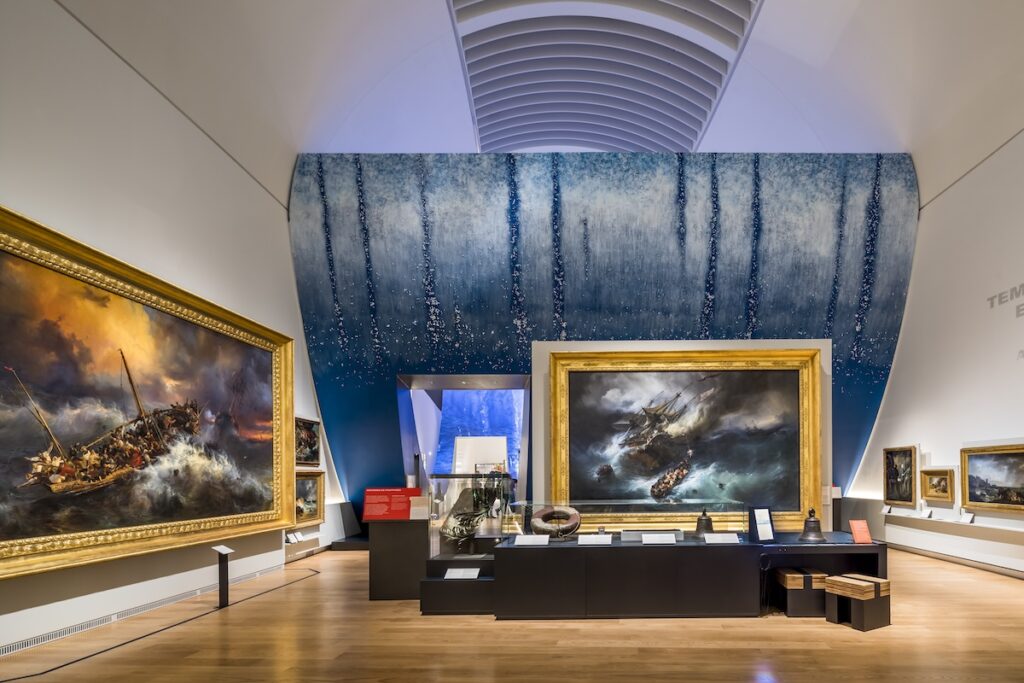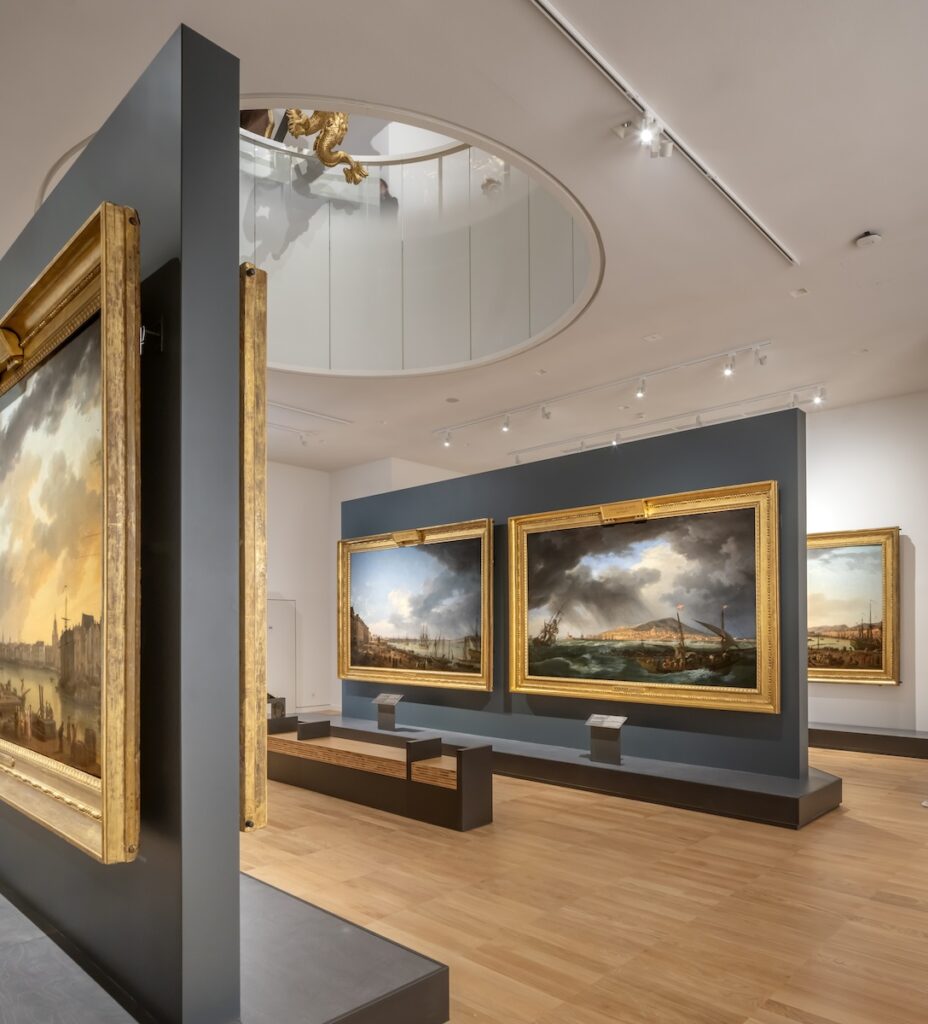Paris’s Musée National de la Marine, reopened in November 2023 after a multi-million-euro, six-year renovation, originated in 1748 with a donation of model ships from the naval engineer and renowned naturalist Henri-Louis Duhamel du Monceau. The initial collections were intended for study, open only to students and officers of the navy. Even then, thought was given to their staging and display. Housed within a series of rooms on the first floor of the Louvre, the models were arranged to appear as part of a bustling maritime infrastructure (Fig. 1). As Jacques-François Blondel describes in his Architecture Française (1756), the models were posed on large tables colored blue “to represent the water of the sea.” Quays added to the ends of the tables gave “the impression of ports.” There were frigates and galleys, ships of the line and yachts, canoes and rafts, all rendered with exactitude and precision. The display also featured elements of naval construction, including masting sheers, forges, and ropemaking facilities. The result, Blondel claimed, was “one of the most interesting curiosities to see in Paris.”[1]

These “curiosities” were opened to the public in 1827 as part of a larger campaign to increase support for the navy.[2] The Musée de la Marine, still housed within the Louvre, was an attempt to correct for what one commentator referred to as France’s “disastrous” continentalism.[3] A common refrain in the mid-nineteenth century was that France was overly focused on terrestrial rather than maritime pursuits, a byproduct of Paris’s location far from the coast. London, favorably located on an estuary stretching to the sea, was a more natural capital for a great maritime nation. Supporters of the museum repeatedly invoked its potential to overcome the failings of geography; it could itself be a “seaport” for Parisians.[4] As Antoine Leon Morel-Fatio, marine painter and later director of the museum, argued, “a country with more than 200 leagues of coasts to defend and commercial interests to protect” needed to “combat in the Government this deadly ignorance of maritime interests.”[5] Art and visual culture were key components of this “combat.” The museum’s collections expanded to include relief maps, port paintings, sculpted busts of celebrated navigators, and thousands of ethnographic objects collected by sailors.
The museum’s collections were relocated to the Palais de Chaillot in 1943, a looming art deco structure built for the 1937 World’s Fair. The recent renovation, which commenced in 2017, had to account for the peculiarity of the building’s curved structure. The renovation’s architects, h2o architects and Snøhetta, chose to emphasize that curvature in ways that, in the museum’s language, respond to the “natural motion of water.”[6] The concern with creating a maritime imaginary—not just exhibiting ships but communicating an environment—remains central to the museum’s premise. The blue tables Blondel described have been replaced by a more fully immersive experience, in keeping with contemporary museography. This begins even before entering the collections with the introduction of a “signature scent” to the museum’s entryway. “Sillage de mer,” made with French seaweed, welcomes visitors with the salty, briny, ineffable smell of the sea.

The “Sillage de mer” is just one of the multisensory experiences proposed by the new museum. The displays emphasize the materiality of the maritime, encouraging visitors to touch the different woods that make up a sailing ship, or to smell the odor of an oil spill. There are sections on human endeavors, including sailing and whaling, and much of the lower level is dedicated to naval power. But the overwhelming impression is one of the alienation of the sea, its essential otherness—an impression announced in the museum’s very first object, a metal diving suit dramatically lit from above in a darkened passageway (Fig. 2). Developed by the brothers Carmagnolle in 1882, the suit borrows the articulated movements of a medieval knight’s armor; twenty small portholes in the helmet transform the wearer’s vision into a mediated stereoscopy. The suit’s striking presence underscores humans’ inability to access the ocean without an elaborate apparatus.

The drama continues in the museum’s scenography. A display about shipwrecks is couched within a massive, curved video projection of roiling waves (Fig. 3). The section devoted to naval power has an array of impressive arms and canons. And the spectacular culmination of the visit is the recently restored stern of the seventeenth-century oared vessel or galley known as La Réale. Made to be the flagship of Louis XIV’s navy, it bears the grandiose gilded iconography of the Sun King. The décor was so grandiose, in fact, that the ship sailed poorly; it was replaced within a few years.
In his review of the new installation, architectural critic Andrew Ayers praised the museum’s structure, especially its lofty volume, but not its scenography. Referring to the large-scale screens, shipping containers, and other immersive gestures, Ayers writes, “these monumental, attention-seeking solids spoil the views across their beautiful pristine voids.”[7] What Ayers terms “attention-seeking solids” also crowd out the collections: of the museum’s holdings of approximately 40,000 objects, just over 1,000 are on display.
More detail on the collections is provided in a catalogue produced to accompany the renovation.[8] Edited by Vincent Bouat-Ferlier and Louise Contant, the catalogue focuses on 200 objects including paintings, drawings, model ships, and scientific instruments, many of which were conserved, restored, and photographed for the first time during the museum’s closure. The authors note the importance of looking across diverse kinds of objects rather than focusing on a single medium, and the collection is hung in such a way as to encourage intermedial conversations between, for example, engravings of whaling, models of whaling ships, and samples of objects made from whale bone including scrimshaw and umbrella handles.

Still, an art historical highlight of the visit is Joseph Vernet’s eighteenth-century Ports of France series, a set of fifteen monumental paintings commissioned by Louis XV that showcase the nation’s major seaports (Fig. 4). The renovation enabled thirteen of the paintings, some of which had previously been held at the Louvre, to be displayed together. These carefully studied canvases give a picture of the mid-eighteenth-century maritime sphere in its commercial, defensive, and imperial guises; they were so thorough and so convincing that when Louis XV was presented with evidence of the diminution of his actual navy he apocryphally replied, “there can be no navy other than that of Vernet.” The story is a strong testament to the power of representation in shoring up a maritime imaginary. Jill Casid has argued that the tableaus go still further, classifying them as a technology of imperialism. She points to evidence of the transatlantic slave trade, for example, in the sugar and rum that feature in Vernet’s view of Toulon and argues that Vernet was making, as much as representing, empire.[9]
Empire, historically one of the primary objectives of the French navy, remains little addressed within the museum’s narratives. A small corner of a display on coffee mentions the transatlantic slave trade and includes a video narrated by Pap Ndiaye, France’s Ambassador to the Council of Europe and a historian specializing in histories of racism and the African diaspora. This brief acknowledgment of forced labor in colonial cultivation overlooks the pervasive role of galley slavery that Meredith Martin and Gillian Weiss detail in The Sun King at Sea (Los Angeles: Getty Publications, 2022). Martin elsewhere observed the absence of references to the violence and oppression of French colonialism in the Hôtel de la Marine, also recently and expensively renovated, and the Musée National de la Marine regrettably follows suit.[10]
Critics of the nineteenth-century museum dismissed it as insignificant, claiming “this collection will never be more than a schoolboy’s toy, a good woman’s entertainment; we might as well have model sailors made of gingerbread.”[11] And there was indeed a group of schoolchildren, delightedly holding up paper ships’ models, on the day of my visit. But France has a serious investment in building its maritime prowess, including through cultural efforts like the Musée de la Marine: the museum’s renovation was initiated by the Minister of Defense. France has the second largest exclusive economic zone—the portion of the ocean under French jurisdiction—in the world. Its oceanic space exceeds those of far larger nations, largely thanks to its collection of overseas territories. This interdependence of terrestrial and maritime space sits uneasily with the museum’s emphasis on the otherness of the oceanic. Upon entering, the press materials urge, the architecture is transporting, “cutting visitors off from the outside world and fostering their total immersion in the world of the sea.”[12] Such a gesture dismisses how important land and place are to the navy. At a moment when France is actively fighting to maintain its hold on the overseas territory of New Caledonia, looking past the museum’s spectacles can reveal deep and longstanding connections between French politics and the maritime imaginary.
Kelly Presutti is Assistant Professor of Art History at Cornell University in Ithaca, NY
[1] Jacques-François Blondel, Réimpression de L’Architecture Française, Vol. 4(Paris: Librairie Centrale des Beaux Arts, 1904-5), 80. Pierre-Édouard Latouche and Jean-François Bédard discuss Blondel’s plans of the Louvre in “A Plan of the Louvre’s Cour Carrée and the Making of the Architecture Française,” Journal18, Issue 2 Louvre Local (Fall 2016).
[2] I discuss the history of this museum and its intersection with French naval politics in more detail in Land into Landscape: Art, Environment, and the Making of Modern France (New Haven: Yale University Press, 2024).
[3] Adolphe Caillé, “Considérations d’art et de politique à propos du Musée de la Marine au Louvre,” (Paris: Dolin, 1839), 4.
[4] A. Jal, “Musée de Marine du Louvre,” L’Athenaeum Français 51 (December 17, 1853), 1212.
[5] Antoine Leon Morel-Fatio, Notice des Collections du Musée de Marine Exposées dans les Galeries du Musée Impérial du Louvre (Paris: Vinchon, 1860), x.
[6] “Reopening of the Musée National de la Marine,” Press Kit (November 2023), 36.
[7] Andrew Ayers, “Paris’s Maritime Museum Reopens after a Belowdecks Overhaul by h2o and Snøhetta,” Architectural Record (December 1, 2023), https://www.architecturalrecord.com/articles/16606-pariss-maritime-museum-reopens-after-a-belowdecks-overhaul-by-h2o-and-snohetta
[8] Vincent Bouat-Ferlier and Louise Contant, Musée national de la Marine: La Collection (Gand: Éditions Snoeck, 2023).
[9] Jill Casid, Sowing Empire: Landscape and Colonization (Minneapolis: University of Minnesota Press, 2005).
[10] Meredith Martin, “Left Bank/Right Bank: Two Views of the ‘Indies’ in Paris,” Journal18 (September 2021).
[11] Léon Gozlan, “Le Musée de la Marine,” L’artiste 12 (1836), 204.
[12] “Reopening of the Musée National de la Marine,” 11.
Cite this note as: Kelly Presutti, “Smell of the Sea: A Review of the Musée National de la Marine,” Journal18 (August 2024), https://www.journal18.org/7398.
License: CC BY-NC
Journal18 is published under a Creative Commons CC BY-NC International 4.0 license. Use of any content published in Journal18 must be for non-commercial purposes and appropriate credit must be given to the author of the content. Details for appropriate citation appear above.
